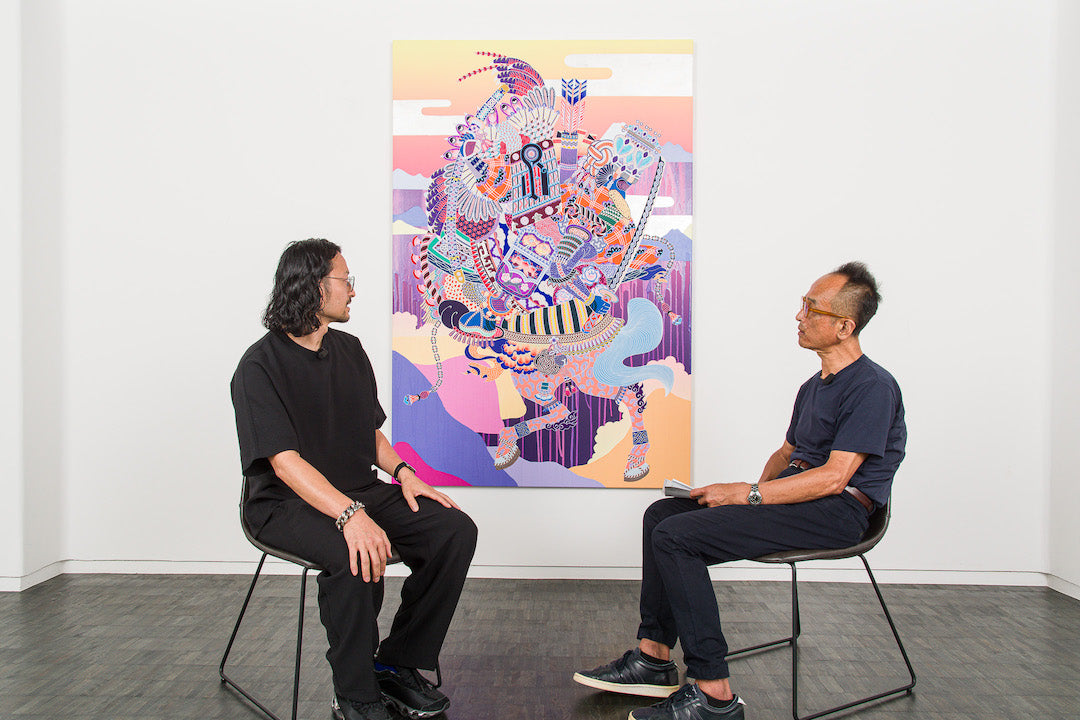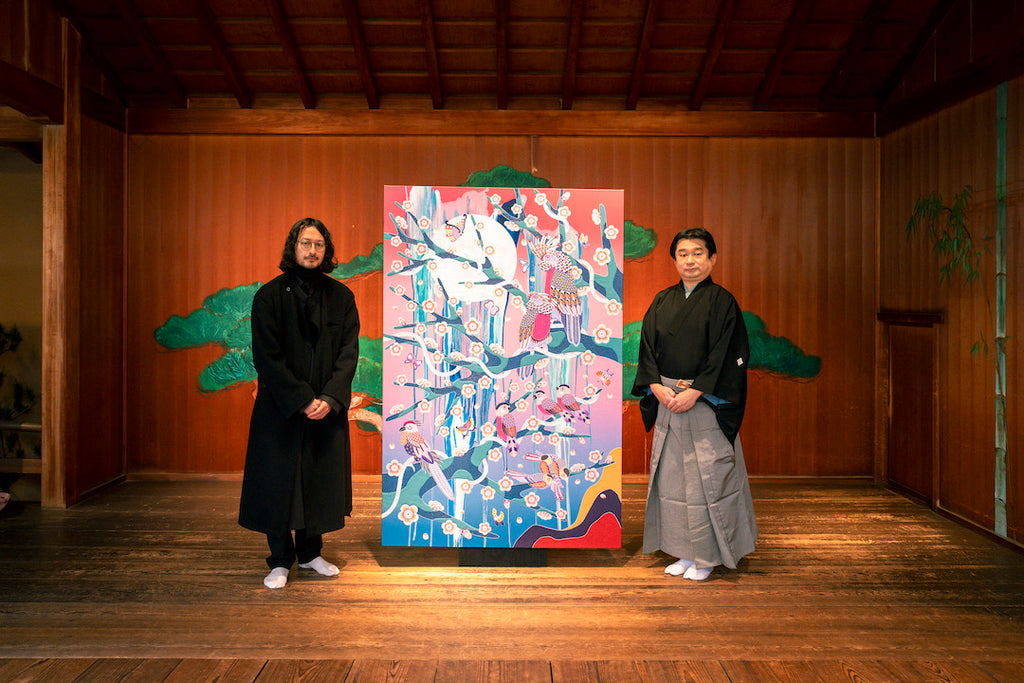ARTICLES
Kohei Kyomori × Meiji Hijikata | Decorative Art Beyond Tradition
2023.10.14
INTERVIEW

Kohei Kyomori × Meiji Hijikata
This series of articles features conversations between various artists and Meiji Hijikata, Director of the Taro Okamoto Museum of Art, Kawasaki, to take a deeper look into their artworks. The second installment is a conversation with Kohei Kyomori, a decorative artist who seeks to create a unique visual language by reinterpreting ornamentation from all ages and cultures through a contemporary perspective.
The first part of their dialogue focused on Kyomori's transition from the world of fashion to fine art. The second part further explores Kyomori's current artistic style, including the materials he uses, his creative process, his past series of paintings, as well as his solo exhibition in Beijing, China. How have his artworks arisen and evolved within his unique world of decorative art? The deep conversation between the two reveals the ambiguity of art.
The Fusion of Digital and Analog

Kohei Kyomori solo exhibition "EXPRESSION M" at the Whitestone Gallery Beijing
Hijikata: One of the most prominent characteristics of your artworks is their exquisite material texture. How do you go about creating these paintings?
Kyomori: First, I create a collage using the materials I have collected up to that point. For my painting called "M Nobu col.1" which served as the main visual for my solo exhibition in Beijing, I wanted to express royalty and authority, so I thought about depicting some kind of military general riding a horse. Based on the collage I made, I then draw it out in full scale with my own hands. Afterward, I import the drawing into a graphic design software, edit it to add colors, and create the base drawing.
After painting over a background sketch with acrylic paint, I use various techniques like dripping and metal leaf gilding to prepare the painting. I then take the digital data I made with the software and print it directly onto the canvas. Lastly, I apply final touches using mineral pigments and resin to finish the surface with a unique material texture.

Kohei Kyomori at work in his studio
Hijikata: So, you incorporate printing directly onto the canvas? That creates a fascinating blend of digital and analog elements. Yet, the final painting still has a strong, handcrafted feel.
Kyomori: Yes, that's right. My background is in graphic design, and while I could have pursued a path where printing was my primary artistic method, it didn’t feel entirely right for me. I wanted to find a way to infuse my work with a personal touch, something that would allow me to merge the artistic materials of today with digital techniques. After experimenting with different approaches, I developed my current style, which is a unique fusion of these elements.

Kohei Kyomori at work in his studio
Hijikata: While it might be a stretch to call your paintings fully three-dimensional, the interplay between the relief-like imagery and the graphic elements creates a powerful synergy. Seeing your work in person reveals a beauty that can't be captured through photos alone.
Kyomori: I always consider how the visual impact will be experienced and how to best convey the essence of the piece. You could say that the entire painting is defined by the strong contrast between the light-absorbing matte of the mineral pigments and the light-reflecting sheen of the resin.
Hijikata: The subtle three-dimensionality and textured surface created by the muted mineral pigments give the painting a rough, tactile quality. This material texture and the depth of color are aspects that can only be truly appreciated in person. The way you combine such distinct elements into a cohesive work is innovative. I doubt someone trained strictly in traditional Japanese or Western painting would approach this challenge in the same way.

Close-up of Kohei Kyomori's "M Maria & George col.1" (2023)
Hijikata: I get a strong impression that the work is handmade, but the colors of the synthetic mineral pigments are also quite unique. These colors cannot be produced from natural mineral pigments. In my work as a judge for open exhibitions on contemporary art, I have noticed that the number of submissions using mineral pigments has increased significantly. It was originally meant to be an open exhibition for Western-style oil paintings, but they do not feel out of place at all. Synthetic mineral pigments not only give vibrant colors, they are also more affordable, so more young artists are starting to use them.
Kyomori: I completely agree. Whenever I visit an art supply store, I’m always captivated by the beautiful colors of the synthetic mineral pigments in the glass jars. I began using them simply because I wanted to work with something that’s made in Japan.

Close-up of Kohei Kyomori's "M Ella col.1" (2023)
The Unique Art of Japan – In the Boundary Between Art and Craft

Kohei Kyomori solo exhibition "EXPRESSION M" at the Whitestone Gallery Beijing
Hijikata: You seem to approach your work in terms of series. What led you to start creating works in this way?
Kyomori: It stemmed from a desire to avoid repeating myself. I want to stay flexible and explore different themes, so I try to begin a new series about once a year. I always aim to do something entirely different with each new project, so I refer to each collection of paintings as a series to indicate that it’s a complete body of work.
Hijikata: The paintings in your "A-UN" series are particularly striking, with a truly captivating material texture. One of the series' highlights is the way the paintings are presented in pairs.
Kyomori: My background in graphic design led me to discover UV resin, which has greatly influenced the texture of my work. There’s a special printing technique called UV printing, where a transparent resin is applied over the printed text. My current use of it emerged from experimenting with how this technique could be applied to paintings.

Meiji Hijikata examines Kohei Kyomori's "A-UN" series of paintings
Hijikata: Historically, there was no clear boundary between art and craft in Japan. As the art historian Nobuo Tsuji often says, what we now call "art" is actually the concept of art we learned from the West, and not the traditional notion of art in Japan.
This is why from the perspective of Western art, your works have a craft-like quality. This is particularly evident in the attention to detail you put in each piece. However, from the perspective of Japanese art, they are not at all a craft, but can be regarded as a modern version of traditional Japanese art.
As for your motifs, the way you skillfully incorporate various decorations also contributes to the work's high degree of perfection. You are able to expertly integrate your knowledge of fashion and graphic design into your art.
Kyomori: The overall composition of my works is significantly influenced by ukiyo-e (Japanese woodblock prints). I draw inspiration from ukiyo-e regarding various aspects, particularly in the way I compose backgrounds with a flat quality.

"UN men No.2" (created by Kohei Kyomori and Unsodo, a woodblock print publisher in Kyoto). 2022, 37.0×24.5 cm, Sheet, Paper, Edition of 100.
Hijikata: Prof. Nobuo Tsuji has mentioned that two key characteristics of Japanese art are "kazari" (ornamentation) and "asobi" (playfulness). While in the Western context, "kazari" might translate to "decoration" or "design," the concept carries a different nuance in Japanese culture. Whether consciously or not, you seem to inherently grasp that ornamentation and playfulness are distinctive charms of Japanese art. Perhaps this understanding comes from your ability to create without being confined by the limitations of Western art perspectives.
Kyomori's Outlook on His Place within Diversity

Kohei Kyomori solo exhibition "EXPRESSION M" at the Whitestone Gallery Beijing
Hijikata: Tell me about the exhibition you did in Beijing back in September 2023.
Kyomori: My recent solo exhibition at Whitestone Gallery Beijing, titled "EXPRESSION M,"used the letter "M" to signify "majesty." In contrast to my previous exhibition, "Impression O," which explored the solemnity and visual impact of religious ornamentation, this new show shifts focus. It invites viewers to contemplate how royalty and figures of authority adorned themselves with ornaments, examining how these decorations symbolized power and how they were perceived by society.

Kohei Kyomori at work in his studio
Hijikata: I believe you have many opportunities ahead to further your art career. How do you envision your future?
Kyomori: My work has taken a distinct path from Western art traditions, and my perspective is quite different as well. Contemporary and minimalist art has often been dominated by white male artists, but there’s growing attention on women, Asians, Africans, and other minority groups. In this evolving landscape, I aim to make my mark as an Asian and Japanese artist, establishing myself through my unique perspective and approach.

Kohei Kyomori × Meiji Hijikata
This conversation between Kohei Kyomori and Meiji Hijikata highlights how Kyomori's art communicates through a distinctive language of decoration, fostering a dialogue across different eras and cultures. His work extends beyond traditional boundaries, using decoration—a fundamental human activity—to offer a universal perspective that transcends cultural backgrounds.
Explore Kohei Kyomori's solo exhibitions and discover the intricate details of his series by visiting our online store.
Click here to view Kohei Kyomori's artworks

Kohei Kyomori solo exhibition "EXPRESSION M" at the Whitestone Gallery Beijing



